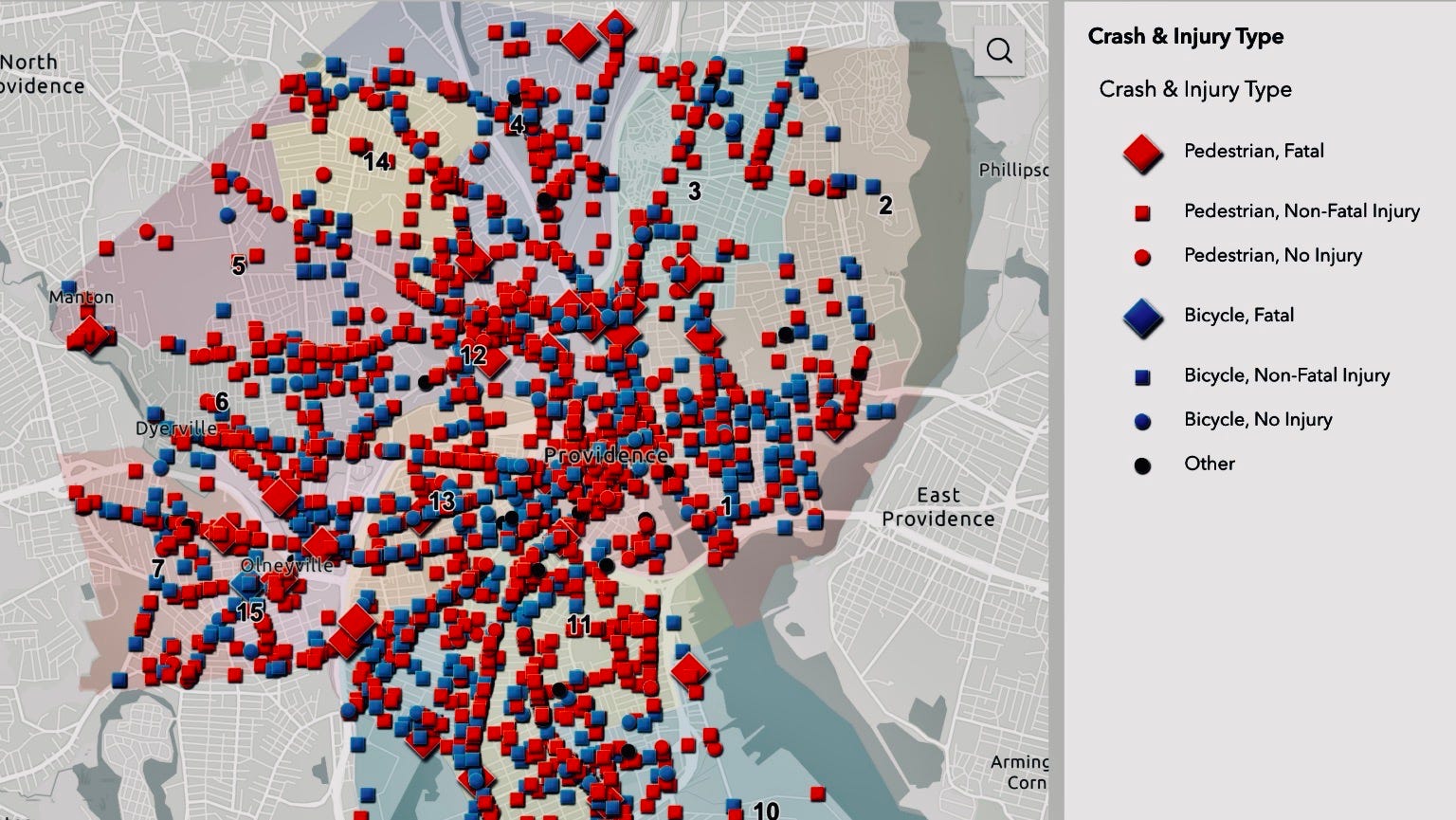Interactive map assembling 13 years of crash data reveals increasing crashes and fatalities
A new interactive data and mapping initiative from the Providence Streets Coalition (PSC) is now available to the public, giving residents and officials a block-by-block visualization of every reported motor vehicle crash involving a person walking or bicycling since 2010.
The
interactive map pinpoints and details more than 3,600 crashes in the City of
Providence in a 13-year timeframe, and reveals the many dangerous areas and
alarming trends facing non-drivers within the City.
Key takeaways from the new initiative
include:
- 2022 was the deadliest year for pedestrians since 2016
- 30 people have been killed by motor vehicles on Providence streets since 2010
- 3,678 pedestrians and cyclists have been hit by motor vehicles since 2010 (2% of Providence’s population)
- 88% of crashes resulted in injuries or fatalities
- 40% of collisions occurred at signaled intersections
- 28% of crashes were hit-and-run
“I am so appreciative of the hard work to create this tool from the Providence Streets Coalition,” said Providence City Councilmember Sue AnderBois (Ward 3).
“We will now be able to better
use data to drive policy and practices to improve the safety of our residents
on our streets and sidewalks. Safely navigating city streets and sidewalks
using whatever mode of transportation you prefer is a non-negotiable quality of
life issue in Providence. I will use this data regularly in Ward 3, especially
as we move forward with the North Main Street Task Force.”
The data does not include the two
pedestrian fatalities on North Main Street that occurred in 2023. Providence
Streets Coalition volunteers will update the map on an annual basis each
spring.
“Every one of the dots on this map represents a human life that has been changed or ended as a result of traffic violence,” said Liza Burkin, PSC lead organizer.
“This isn’t something
that we accept as an inevitable outcome of the road network that we have
built.” The map confirms much of the findings of the city’s High Injury Network which shows the top
dangerous intersections and corridors throughout the City.
The release of the data comes amid renewed focus on Providence’s commitment to Vision Zero, a pledge that the City will work to achieve zero traffic fatalities and severe injuries on its streets.
“Our hope is that, combined with a commitment to
Vision Zero, this map will help us identify hot spots and trends, and make
life-saving changes to our road network,” said Burkin.
The initiative results from ongoing efforts by PSC to access critical street-level data on incidents of traffic violence involving pedestrians and cyclists. The source data for this project were provided by the City of Providence in response to public records requests under APRA (Rhode Island’s Access to Public Records Act law).
Similar data sought from the Rhode Island Department of Transportation (RIDOT)
have been repeatedly denied, although the City’s data includes crashes that
occurred along state-maintained roads.
“Open access to traffic safety data is critical to a community understanding their transportation challenges and developing strategies to address them,” said Eric Jackson, Executive Director of the Connecticut Transportation Institute and an advisor to the project.
“Tools to support understanding and knowledge should be
available to those interested in making a difference. The data collected,
maps generated, and analysis conducted should drive our decisions to improve
safety for all road users, with a priority on our most vulnerable.”
The monumental effort to assemble and clean more than a decade's worth of reports was led by a team of dedicated volunteers who painstakingly cataloged and mapped data obtained from the City.
“By
bringing this information to the surface we hope to inform and inspire action
to build streets that are safe for everyone, no matter your mode of choice,”
said Derek Wietsma, one of the project leaders, adding, “Ultimately this
project is about a bunch of volunteers coming together to make our city and
communities safer.”
